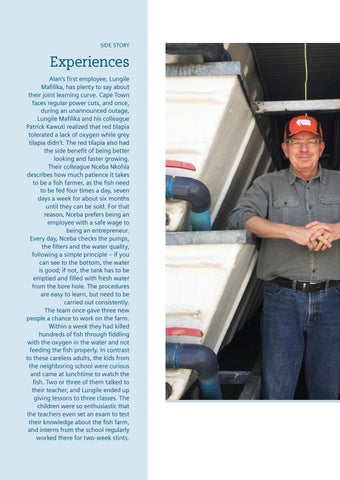Side story
Experiences Alan’s first employee, Lungile Mafilika, has plenty to say about their joint learning curve. Cape Town faces regular power cuts, and once, during an unannounced outage, Lungile Mafilika and his colleague Patrick K awuti realized that red tilapia tolerated a lack of oxygen while grey tilapia didn’t. The red tilapia also had the side benefit of being better looking and faster growing. Their colleague Nceba Nkohla describes how much patience it takes to be a fish farmer, as the fish need to be fed four times a day, seven days a week for about six months until they can be sold. For that reason, Nceba prefers being an employee with a safe wage to being an entrepreneur. Every day, Nceba checks the pumps, the filters and the water quality, following a simple principle – if you can see to the bottom, the water is good; if not, the tank has to be emptied and filled with fresh water from the bore hole. The procedures are easy to learn, but need to be carried out consistently. The team once gave three new people a chance to work on the farm. Within a week they had killed hundreds of fish through fiddling with the oxygen in the water and not feeding the fish properly. In contrast to these careless adults, the kids from the neighboring school were curious and came at lunchtime to watch the fish. Two or three of them talked to their teacher, and Lungile ended up giving lessons to three classes. The children were so enthusiastic that the teachers even set an exam to test their knowledge about the fish farm, and interns from the school regularly worked there for two-week stints.
